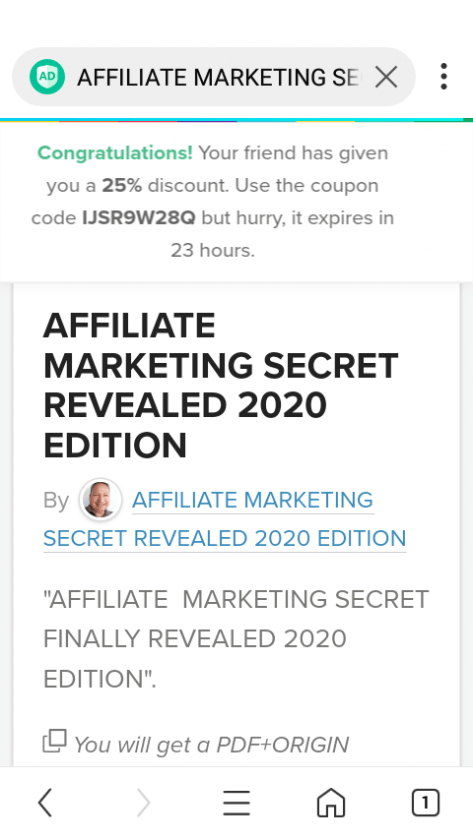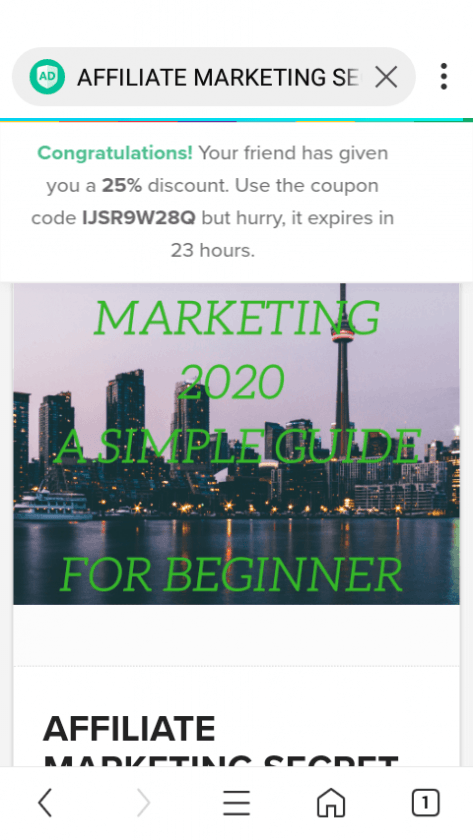Affiliate Marketing 2.0

Policy | Affiliate Disclosure
© 2012-2021 Smart Blogger —
Boost Blog Traffic, Inc.
Affiliate
Marketing in
2021: FREE
Guide for
Beginners
Leanne Regalla 145
Comments
Updated: Nov 9, 2021
In This Guide: What is
Affiliate Marketing? |
How to Start Affiliate
Marketing in 4 Steps | 4
Types of Affiliate
Products to Promote |
The Bottom Line on
Affiliate Marketing
If you’d like to make passive
income with affiliate
marketing, this post is going to
become your go-to guide.
Not only am I going to teach
you the basics of how to
become an affiliate marketer,
but we’ll also dive into some
real examples from
professional affiliate marketers
who are making thousands or
even millions of dollars per
year without spending money
on PPC or any of that
nonsense.
We’ll cover promoting
products on Amazon, creating
SEO-optimized content that
ranks well on Google, email list
promotion strategies, and how
to choose the best affiliate
program for you.
We’ll also provide a step-by-
step guide to the whole
process, so you’ll be earning
affiliate commissions in no
time.
Let’s dive in.
We’ll start with a (somewhat
long-winded) definition:
What is Affiliate
Marketing?
Affiliate marketing is the
practice of promoting the
products or services of another
person or company in
exchange for a commission on
the resulting sale. Affiliate
marketers join affiliate
programs, find reputable
affiliate products to promote,
and then share those products
with their audiences.
Basically, it’s a modern
interpretation of a very old
idea — getting a commission
on a sale.
If you’ve been listening to us
for long, you’ve learned
that bloggers make money by
building an audience who
trusts them, and then by
offering products or services
that will genuinely help that
audience.
Affiliate marketing is really just
a quick way to offer products
and services without having to
create your own products and
services.
For bloggers, that means you
find a product or service that
you like, promote it to your
readers, and earn part of the
profit on each sale that you
make.
How Does Affiliate
Marketing Work?
Affiliate marketing can get
pretty technical, even for those
well-versed in digital
marketing. Fortunately, you
don’t need to know all the
details to get started.
Download our
Affiliate Marketing
Guide(a handy, free PDF
packed with info)
The actual mechanics run in
the background, thanks to the
merchant’s affiliate software.
But here’s a quick look behind
the scenes:
1. When an affiliate joins the
merchant’s program, he or
she is given a unique ID
and a specific URL to use
when promoting the
company’s product.
2. The affiliate includes the
link in their blog post and/
or via their email marketing
efforts and invites readers
to click it to find out more.
3. When a potential buyer
clicks on the link to visit
the affiliate partner’s site, a
cookie identifying the
affiliate is placed on the
website visitor’s computer.
The cookie ensures that the
publisher is credited with
the referral sale even if it
occurs days or even weeks
later.
4. Whenever a buyer
completes the sale
process, the merchant
checks the sales record for
a cookie identifying the
source of the referral.
5. If the merchant finds a
cookie with an affiliate ID,
the affiliate is credited with
the sale.
6. The merchant makes
reports available so that the
affiliate can see their
referrals (clicks) and sales.
7. The merchant pays the
affiliate commission at the
end of each payment period
(i.e. revenue sharing).
Here’s a graphical overview to
help you visualize the process:
The flow is pretty
straightforward once you
understand it, and it works the
same no matter what kind of
product you’re promoting or
how established you are as an
affiliate marketer.
So let’s look at the typical
progression for a blogger
who’s serious about making
affiliate marketing a major
source of income.
Back to Top
How to Start Affiliate
Marketing in 4 Steps
Here’s the key point you need
to understand if you want to
become an affiliate marketer:
You’re earning a
commission in
exchange for giving
readers valuable
insights on products or
services they were
already thinking about
purchasing.
In other words, your readers
are already buying things. They
are already going to make a
purchase whether or not you
give them any advice.
The question is, could you help
them make a smarter decision
than they could alone?
Because that’s where you add
value. You earn a commission
in exchange for being an
influencer and helping people
make smarter decisions, and
you use your blog and the
Internet to systemize that
process, providing valuable
advice to thousands of people.
Here’s a step-by-step process
for doing exactly that:
Step 1: Choose a
Product to Promote as
an Affiliate
As ethical content creators,
we’re constrained in the
products we choose to
represent in one of two ways:
Either we’re limited
by our experience to
products that we’ve
used and liked, that
have affiliate
programs and that
are a good fit for our
audience, or
We’re constrained by
the products we can
get access to in order
to evaluate them,
either by buying them
outright or getting a
free sample or trial.
No matter which approach you
take, expect to have to invest
time and money into
researching the best products
for your audience.
Here are your two main
options (with your best option
listed first).
OPTION #1: PROMOTE
PRODUCTS YOU ALREADY
KNOW AND LOVE
This is the most common way
to get started with affiliate
offers.
You become an affiliate for
something that you’ve used
yourself, had a good
experience with, thoroughly
tested and feel good
recommending. You should be
fairly confident that others will
get the same results you did
(or better), as long as they do
the work.
If you’ve found great success
from a course, mastermind, or
ebook that your readers could
also benefit from, it only
makes sense for you to spread
the word and share your
results.
Do an inventory of the
products, services, and
courses you already have
experience with. You might
have a list of a dozen or more.
Which of these would you be
thrilled to promote? Cross out
any that don’t fit the bill.
Now simply check to see if the
merchant has an affiliate
program (some won’t but
you’ll probably be surprised at
how many do).
Using a search engine like
Google, search for “affiliate
program” + [product name], or
simply email the merchant and
ask.
Then run your remaining
options through this Good
Affiliate Product checklist:
You’ve previewed the
product so you know
its quality (given, in
this case).
They have a solid
refund policy that you
trust they’ll honor.
They provide good
customer support
(and you’ve tested it).
You have a good
story to share about
your experience with
the product.
The offer fits your
audience’s needs and
won’t abuse the trust
you’ve built with
them.
The products that tick all the
checkboxes are your best
opportunities for affiliate
revenue. As time goes on, add
as many of these products to
your mix as you like.
You’ve found your first product!
Apply using the merchant’s
process and start promoting.
If you’re just dipping your toe
in the affiliate marketing
industry, this first option may
be enough to get you started.
However, most bloggers will
want to try the next one, too.
(And you’ll have to explore the
second option if you don’t
have an existing product you
love that is also a great match
for your audience and offers an
affiliate program.)
Option #2: Find Products Via
an Affiliate Network
If you don’t have any direct
experience with or knowledge
of products in your niche that
could help your readers, you
can often find good affiliate
products on affiliate
networks (← our detailed
guide).
But be careful — this approach
requires that you invest time
into research and money into
purchasing products to try out,
more so than the first option.
That’s because there’s less
trust and prior knowledge
involved from the outset. You
have to do your due diligence
to protect your reputation and
the credibility you’ve built with
your readers.
When you work through a
network, you typically won’t
know the merchant ahead of
time and usually won’t build a
relationship with them (your
business relationship is with
the network).
The list of popular and reliable
affiliate networks includes
ClickBank , CJ Affiliate , the
eBay Partner Network ,
ShareASale , CJ Affiliate (aka
Commission Junction), and the
Amazon Associates program .
Some networks will even
assign you an affiliate manager
to lend a hand and show you
the ropes.
Amazon products, in particular,
are an easy way to get started.
Many newbies begin by
becoming an Amazon affiliate
and then scaling to other types
of more profitable affiliate
offers.
Step 2: Get Yourself Set
Up as an Affiliate
Whether you work directly with
affiliate merchants or through
a network, you’ll have to apply,
be approved, and provide
certain information so that you
can be paid.
At a minimum you’ll need to
provide:
Your personal/
business contact
information for tax
and reporting
purposes.
Your bank account
where commissions
will be sent.
In turn, the merchant must
provide you with:
An affiliate link.
Whenever you post
about the product,
you’ll use this
trackable link. It will
have a long tag at
the end of each link
that includes your
affiliate ID.
Here’s what some typical
affiliate text links look like:



Leave a Message